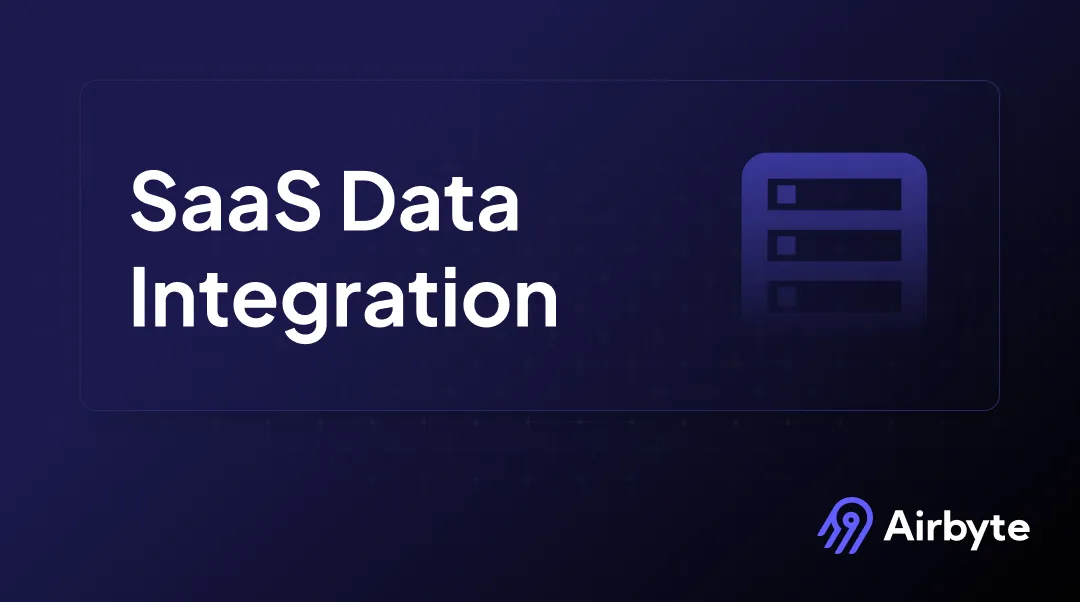Best SaaS Data Integration Tools in 2026
Summarize this article with:
✨ AI Generated Summary
SaaS data integration connects multiple cloud and on-premises applications to enable seamless, automated data flow, improving efficiency, data quality, and real-time insights. Key integration approaches include ETL/ELT, real-time streaming, and AI-driven automation that enhance schema mapping, error handling, and predictive maintenance.
- Top platforms in 2025: Airbyte (open-source, scalable), Zapier (no-code), Workato (enterprise-grade), MuleSoft (API-led), Tray.io (low-code), Boomi, Celigo, and Jitterbit.
- Integration approaches: native coding, iPaaS, RPA, and hybrid strategies tailored to organizational needs.
- Benefits: automated workflows, improved data consistency, self-service analytics, real-time reporting, and enhanced customer experiences.
- Challenges: technical complexity, vendor lock-in, security/compliance risks, and resource demands.
- Security best practices: multi-layered encryption, zero-trust architecture, compliance automation, and supply chain security assessments.
SaaS—software-as-a-service—applications now sit at the top layer of the data stack for nearly every data-driven organization. From CRMs and marketing platforms to operational databases, you're probably using dozens of SaaS tools every day.
With so many systems in play, moving data from one platform to another for backups, analytics, or other data management tasks is essential. That's where SaaS data integration comes in, providing a holistic approach to moving data to—and from—any application.
Today the landscape includes 30,000+ SaaS applications worldwide, creating unprecedented complexity alongside new opportunities for innovation and efficiency. This guide explains what SaaS data integration is, how it works, the latest AI-driven trends, leading platforms, and the benefits and challenges you should know about.
What Is SaaS Data Integration and Why Does It Matter?

Traditionally, moving information between systems meant manual exports and imports—time-consuming and error-prone processes that consumed valuable resources. Modern organizations also struggle with siloed data that blocks company-wide analysis and automation, creating bottlenecks that prevent teams from making data-driven decisions quickly.
SaaS data integration solves these issues by synchronizing two or more applications—on-premises software, cloud apps, databases, CRMs—via APIs and other connection methods. The result is a unified data ecosystem where information flows seamlessly, enabling real-time insights and automated workflows that transform how businesses operate.
Core Integration Patterns
Modern saas data integration platforms support multiple architectural approaches:
- ETL (Extract-Transform-Load) - Traditional approach where data is extracted, transformed, then loaded
- ELT (Extract-Load-Transform) - Modern approach leveraging cloud data warehouse power for transformations
- Real-time streaming architectures - Continuous data flow for immediate insights and actions
For example, if you run an online store on Shopify and your accounting team uses FreshBooks, integration can automatically push every new purchase into the accounting software. Advanced features—bi-directional sync, conflict resolution, transformation engines—maintain data integrity across all business processes while reducing manual intervention.
This automation extends beyond simple data copying. Modern platforms can enrich data, apply business rules, handle complex transformations, and manage error scenarios automatically, creating robust data pipelines that support critical business operations.
How Does SaaS Data Integration Actually Work?
SaaS data integration platforms rely on APIs that authenticate, authorize, and move data in real-time or batch mode. The underlying architecture has evolved significantly to support modern cloud-native applications and distributed systems.
Modern platforms support multiple connection methods:
- REST APIs for standard web service communication
- Webhooks for event-driven workflows that trigger immediate actions
- GraphQL for efficient querying and reduced data transfer
- Message queues for asynchronous processing and improved reliability
The Integration Process
Typical integration workflows follow these essential steps:
- Data discovery and mapping – Platforms automatically scan source systems to map schemas, identify relationships, and suggest field mappings between different systems.
- Authentication and authorization – Secure connection establishment using OAuth, API keys, or other authentication methods while respecting security policies.
- Triggers and events – User actions (such as a new customer signup) or scheduled intervals fire events that initiate data movement between connected systems.
- Data transformation and enrichment – Convert formats, apply business logic, validate data quality, and enrich information with additional context or calculated fields.
- Error handling and retries – Robust systems manage API rate limits, network interruptions, data validation failures, and provide comprehensive logging for troubleshooting.
Advanced Capabilities
Leading platforms now include sophisticated features that handle complex enterprise requirements:
Schema evolution management automatically adapts to changes in source systems without breaking existing integrations. Conflict resolution handles scenarios where the same data is modified in multiple systems simultaneously. Data lineage tracking maintains complete audit trails showing how data moves and transforms across your entire ecosystem.
How Are AI-Driven Integration and Automation Transforming the Industry?
Artificial intelligence is revolutionizing how organizations approach saas data integration, moving beyond simple point-to-point connections to intelligent, self-managing data ecosystems.
Intelligent Data Mapping and Schema Evolution
AI-powered platforms can automatically detect relationships between different data sources and suggest optimal field mappings, significantly reducing setup time. When source systems update their schemas or add new fields, machine learning models automatically adapt existing mappings and alert users to potential conflicts.
Natural-language processing capabilities now allow non-technical users to describe desired workflows in plain English. The platform interprets these descriptions and automatically assembles the necessary integration components, democratizing data integration beyond technical teams.
Predictive Analytics for Integration Health
Machine-learning models continuously monitor integration performance, data quality metrics, and system health indicators. These models forecast potential failures, capacity constraints, and anomalies before they impact business operations.
Advanced platforms use predictive analytics to:
- Anticipate API rate limit violations and automatically adjust processing schedules
- Identify data quality degradation trends and recommend corrective actions
- Optimize resource allocation based on historical usage patterns
- Suggest new integration opportunities based on data flow analysis
Automated Data Quality and Governance
AI-driven data quality engines automatically detect anomalies, validate business rules, and suggest data cleansing strategies. These systems learn from historical corrections to improve accuracy over time, reducing the manual effort required to maintain high data quality standards.
Which Are the Top SaaS Data Integration Platforms in 2025?
1. Airbyte

Airbyte is an open-source data-integration platform with over 600 pre-built connectors that has established itself as a leader in the modern data integration space. The platform follows a modern ELT approach and supports Change Data Capture (CDC) for real-time updates, while serving over 7,000 enterprises including significant Fortune 500 adoption. You can extend it with custom connectors via its Connector Development Kit or PyAirbyte, making it highly adaptable to specific organizational requirements.
The platform has achieved significant industry recognition, including inclusion in Fast Company's list of World's Most Innovative Companies for 2025 and CRN's AI 100 and Big Data 100 lists. Airbyte's unique positioning combines open-source flexibility with enterprise-grade security and governance capabilities, enabling organizations to avoid vendor lock-in while maintaining sophisticated data integration capabilities.
Recent product developments include unified structured and unstructured data movement capabilities, multi-region deployment options for enhanced data sovereignty, and AI-readiness features that support modern machine learning workflows. The platform processes over 2 petabytes of data daily across customer deployments, demonstrating its scalability and reliability for enterprise workloads.
Airbyte's community-driven development model has attracted over 230,000 members who contribute to ongoing platform evolution, ensuring rapid innovation and broad connector ecosystem coverage. The platform supports flexible deployment options including cloud-managed services, self-hosted enterprise deployments, and hybrid architectures that meet diverse organizational requirements.
Key Strengths:
- Open-source foundation with capacity-based pricing eliminates connector licensing fees
- Highly extensible platform with Connector SDK and PyAirbyte for custom development
- Strong community support and rapid connector development
- Enterprise-grade security and governance features
Considerations:
- Moderate learning curve for teams transitioning from legacy ETL tools
- Technical implementation may require data engineering expertise
2. Zapier

Zapier democratizes automation with its no-code approach, connecting 8,000+ applications through intuitive "Zaps" that non-technical users can create and manage independently.
Key Strengths:
- Extremely user-friendly interface requires no technical skills
- Massive ecosystem of pre-built connectors and integrations
- Quick setup and immediate results for simple automation workflows
- Strong community and extensive documentation
Considerations:
- Limited capabilities for complex business logic or data transformations
- Costs can escalate quickly with high-volume usage
- Less suitable for enterprise-scale data integration requirements
3. Workato
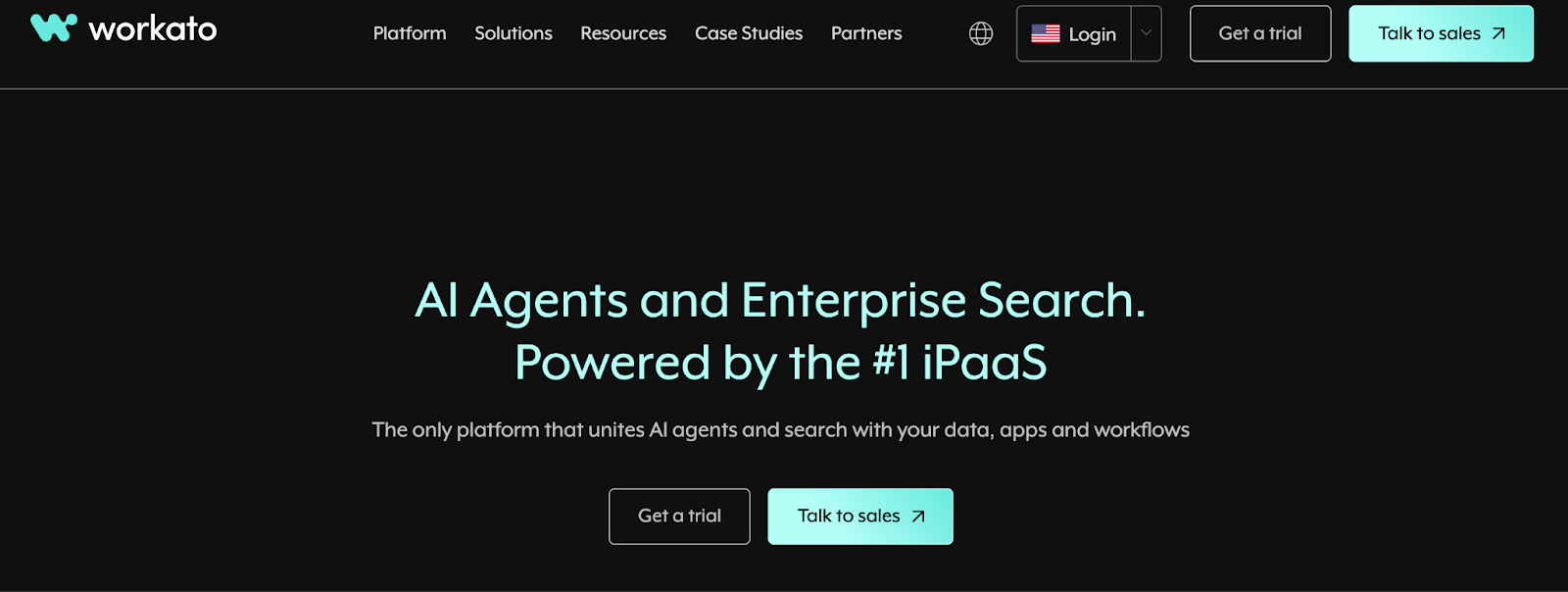
Workato combines enterprise-grade capabilities with user-friendly recipe-based workflows, making it ideal for organizations that need powerful integration capabilities with business user accessibility.
Key Strengths:
- Sophisticated automation capabilities with conditional logic
- Strong enterprise governance and security features
- Excellent balance of ease-of-use and advanced functionality
- Comprehensive monitoring and error handling
Considerations:
- Enterprise pricing may be prohibitive for smaller organizations
- Learning curve for advanced features
4. MuleSoft
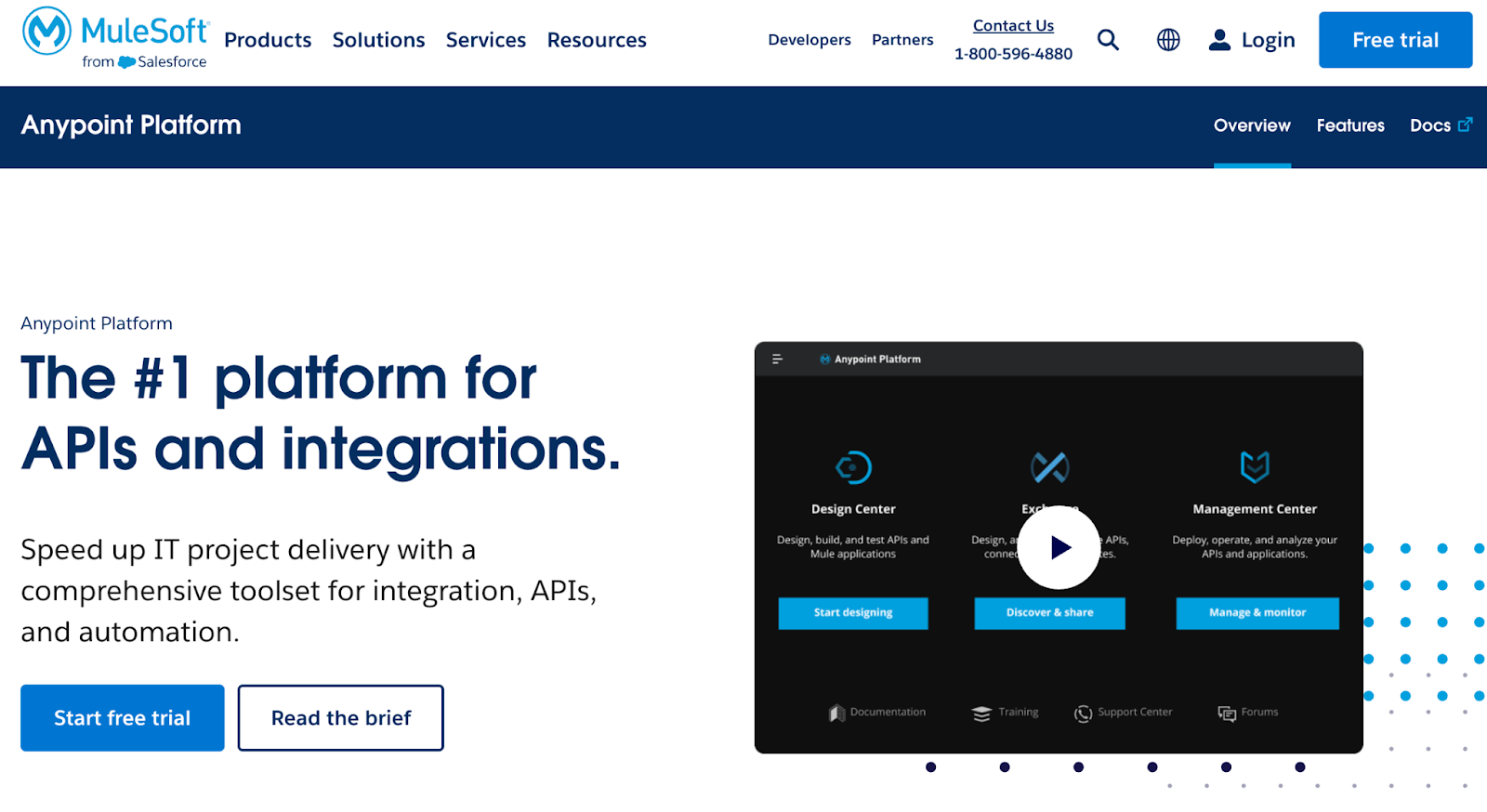
MuleSoft's API-led connectivity approach makes it the preferred choice for large enterprises with complex integration requirements and existing API management needs.
Key Strengths:
- Comprehensive API management and governance capabilities
- Enterprise-grade security, monitoring, and performance
- Strong support for complex, high-volume integrations
- Extensive customization and development capabilities
Considerations:
- High cost and complexity may not be justified for smaller organizations
- Steep learning curve requires specialized expertise
- Implementation typically requires significant time and resources
5. Tray.io
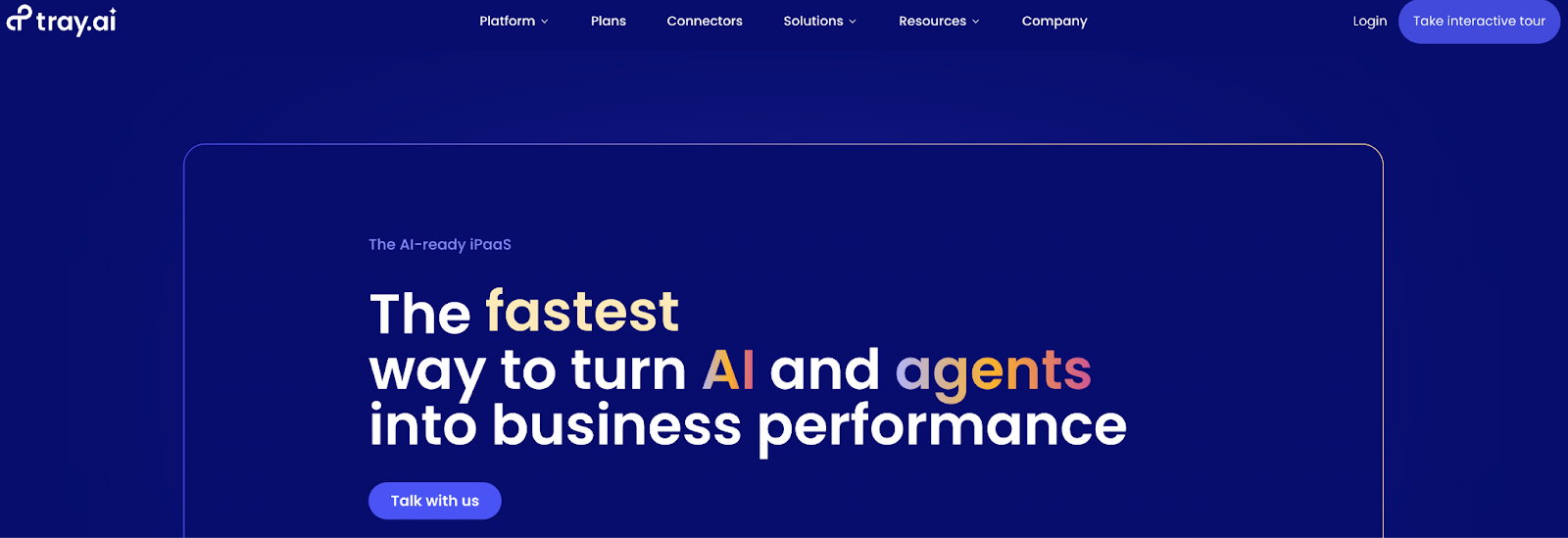
Tray.io offers a low-code integration builder with advanced scripting support for creating sophisticated workflows that balance ease of use with powerful customization capabilities. The platform serves mid-to-large businesses requiring flexible integration solutions.
Key Strengths:
- Highly customizable platform supports complex integration requirements and advanced business logic
- Scalable architecture grows with enterprise needs while maintaining performance standards
Considerations:
- Pricing transparency limitations require direct sales engagement for cost evaluation
- Advanced capabilities require training and technical expertise for optimal utilization
6. Boomi

Boomi excels in hybrid cloud and on-premises deployments with strong data transformation capabilities that support organizations with diverse infrastructure requirements. The platform provides comprehensive integration solutions for complex enterprise environments.
Key Strengths:
- Flexible deployment options support hybrid cloud and on-premises infrastructure requirements
- Intuitive drag-and-drop interface simplifies integration development and management
- Master data management add-ons provide comprehensive data governance capabilities
Considerations:
- Premium pricing structure increases total cost of ownership for smaller implementations
- User interface design feels outdated compared to modern integration platform alternatives
7. Celigo

Celigo focuses specifically on eCommerce and ERP integrations with pre-built templates that accelerate deployment for common business scenarios. The platform serves organizations requiring rapid implementation of standard integration patterns.
Key Strengths:
- Pre-built templates for popular applications significantly reduce implementation time
- Responsive customer support team provides effective assistance during deployment and operation
Considerations:
- Limited flexibility for complex or non-standard integration requirements
- Usage-based pricing model can become expensive as data volumes and complexity increase
8. Jitterbit
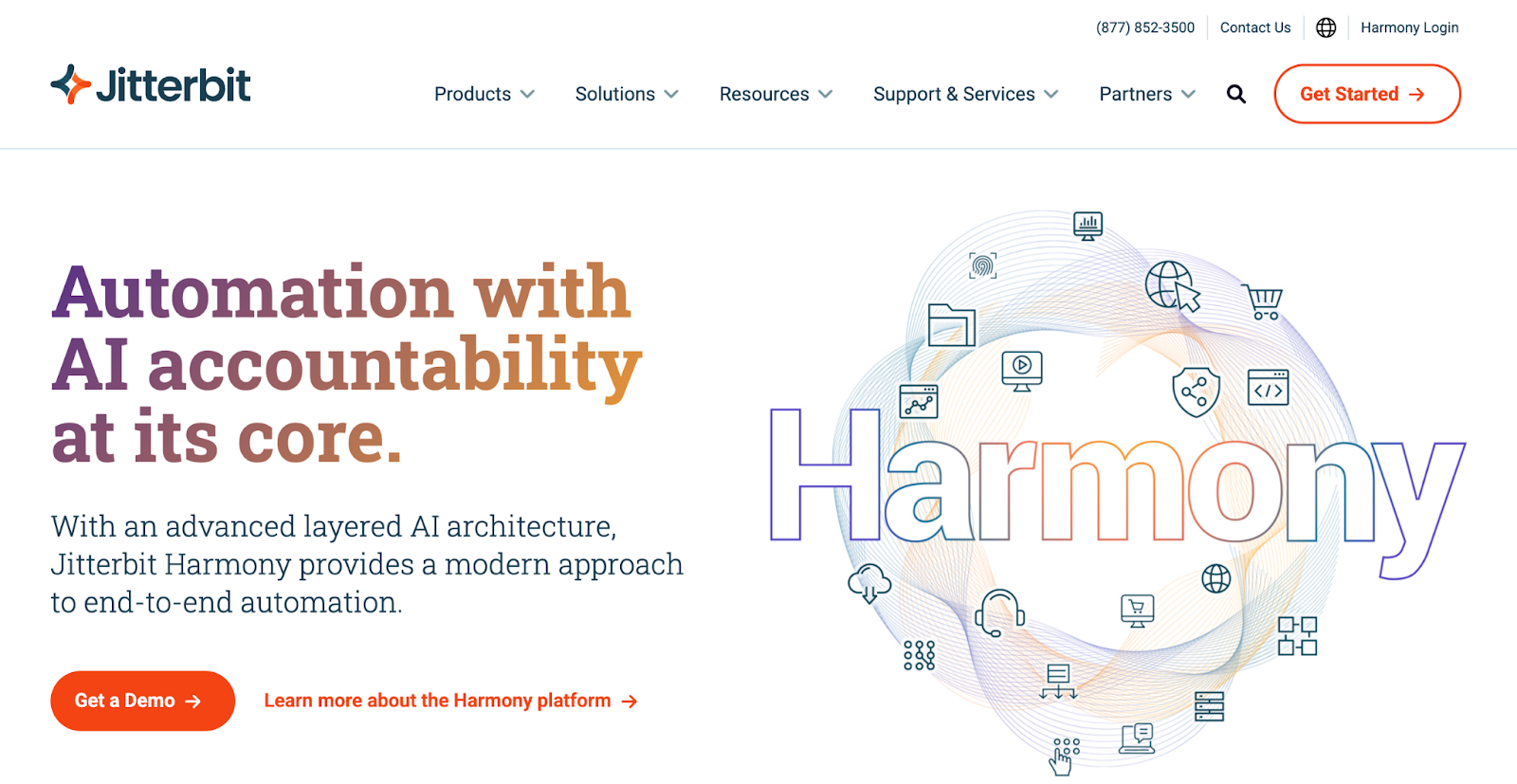
Jitterbit specializes in bridging legacy systems with modern SaaS applications, providing organizations with capabilities to modernize their integration infrastructure gradually. The platform's transformation engine supports complex data processing requirements.
Key Strengths:
- Rapid API creation capabilities enable quick connectivity to legacy systems and modern applications
- Robust transformation engine handles complex data processing and format conversion requirements
Considerations:
- Pricing tier structure may not be optimal for smaller teams with limited integration requirements
- User interface design could benefit from modernization to improve usability and developer experience
What Are the Different Approaches to SaaS Data Integration?
Organizations can choose from several integration approaches based on their specific requirements, technical capabilities, and strategic priorities.
Choosing the Right Approach
Native integration provides maximum control and customization but requires significant development resources and ongoing maintenance. This approach works best when you have specific requirements that existing platforms cannot address or when dealing with highly sensitive data that requires custom security implementations.
iPaaS solutions offer the best balance for most organizations, providing pre-built connectors, visual workflow builders, and managed infrastructure while maintaining reasonable costs and implementation timelines.
RPA approaches serve as bridges for systems that lack modern API access, though they typically require more maintenance and are less reliable than API-based integrations.
Hybrid strategies allow large organizations to optimize each integration based on specific requirements, using iPaaS for standard connections while developing custom solutions for unique or highly sensitive scenarios.
What Are the Key Benefits of SaaS Data Integration?
Modern saas data integration delivers transformative benefits that extend far beyond simple data movement, creating competitive advantages through improved efficiency, insights, and customer experiences.
Automated Business Processes
Integration platforms eliminate manual data entry and repetitive tasks that consume valuable employee time. Teams can focus on strategic initiatives rather than routine data manipulation, while automated workflows ensure consistent execution of business processes.
Examples include automatic customer data synchronization between CRM and marketing platforms, real-time inventory updates across sales channels, and seamless financial data flow from operational systems to accounting platforms.
Enhanced Data Quality and Consistency
Centralized data integration creates a single source of truth by establishing authoritative data sources and maintaining consistency across all connected systems. Built-in validation rules, data cleansing capabilities, and conflict resolution mechanisms ensure high data quality throughout your organization.
This consistency enables more accurate reporting, better decision-making, and improved compliance with regulatory requirements.
Data Democratization and Self-Service Analytics
Integration platforms enable business users to access data independently without requiring technical support for routine requests. Self-service capabilities reduce bottlenecks in data access while empowering teams to explore insights and make data-driven decisions quickly.
Modern platforms include user-friendly interfaces that allow non-technical staff to create reports, build dashboards, and access the information they need for daily operations.
Streamlined Reporting and Real-Time Insights
Unified data enables comprehensive reporting across all business systems, providing leadership with holistic views of organizational performance. Real-time data synchronization ensures that dashboards and KPIs reflect current business conditions rather than outdated snapshots.
This capability supports agile decision-making and rapid response to market changes or operational challenges.
Improved Customer Experience
360-degree customer views created through data integration enable personalized experiences, better customer support, and more effective marketing campaigns. When all customer touchpoints share consistent, up-to-date information, organizations can deliver seamless experiences that build loyalty and drive revenue growth.
What Are the Main Challenges of SaaS Data Integration?
While saas data integration offers significant benefits, organizations must navigate several challenges to achieve successful implementations and ongoing operations.
Integration Complexity and Technical Challenges
Managing diverse data schemas, API limitations, and performance requirements across multiple systems creates technical complexity that requires specialized expertise. Different systems may use incompatible data formats, have varying update frequencies, or impose rate limits that affect integration performance.
Legacy systems often lack modern API capabilities, requiring creative solutions or workarounds that increase implementation complexity and maintenance overhead.
Vendor Lock-In and Platform Dependencies
Proprietary integration platforms may create dependencies that limit future flexibility and increase switching costs. Organizations risk being constrained by vendor roadmaps, pricing changes, or platform limitations that don't align with evolving business needs.
Open-source alternatives and platforms that generate portable code help mitigate these risks by maintaining organizational control over integration logic and data flow.
Security and Compliance Risks
Multiple integration points increase the attack surface and potential compliance vulnerabilities. Each connection must be secured appropriately, monitored continuously, and maintained according to regulatory requirements.
Data governance becomes more complex when information flows across multiple systems, requiring comprehensive audit trails, access controls, and data protection measures.
Resource Intensity and Skill Requirements
Successful integration initiatives require skilled personnel who understand both technical implementation and business requirements. Organizations must invest in training, hire specialized talent, or partner with experienced vendors to achieve optimal results.
Ongoing maintenance, monitoring, and optimization require dedicated resources that organizations must plan for in their long-term strategies.
How Should You Address Security and Compliance in SaaS Data Integration?
Security and compliance considerations become increasingly critical as data integration expands across more systems and jurisdictions. Organizations must implement comprehensive strategies that protect sensitive information while enabling business capabilities.
Multi-Layered Security Architecture
Implement robust encryption for data both at rest and in transit, using industry-standard algorithms and key management practices. Strong identity and access management (IAM) systems ensure that only authorized users and systems can access sensitive data.
Network security measures, including VPNs, firewalls, and secure connection protocols, protect data movement between systems. Regular security assessments and penetration testing help identify and address vulnerabilities before they can be exploited.
Compliance Automation and Documentation
Automated compliance capabilities help organizations maintain adherence to regulations like GDPR, HIPAA, SOC 2, and industry-specific requirements. Data lineage tracking provides complete audit trails showing how information flows through your systems.
Regular compliance assessments, automated policy enforcement, and comprehensive documentation support regulatory audits and demonstrate organizational commitment to data protection.
Zero-Trust Architecture and Supply Chain Security
Implement zero-trust principles that verify every request and user, regardless of their location or previous access history. This approach minimizes risks from compromised accounts or internal threats.
Evaluate the security practices of all integration platform vendors and third-party connectors. Supply chain security reviews ensure that your data protection standards extend throughout your integration ecosystem.
Conclusion
Becoming a connected enterprise requires breaking down data silos and automating workflows across your SaaS stack to unlock the full potential of your data investments. Modern platforms—especially open-source options like Airbyte—now combine AI-driven automation with enterprise-grade security, enabling organizations to integrate faster while avoiding vendor lock-in.
The landscape continues evolving with AI-powered capabilities, improved user experiences, and enhanced security features that make integration more accessible and powerful than ever before. Choose the approach that balances speed, flexibility, and governance for your specific needs, and you'll unlock richer insights, happier customers, and a stronger competitive edge in your market.
FAQ
What is SaaS data integration?
SaaS data integration is the process of connecting different software-as-a-service applications so they can automatically share and synchronize data, eliminating manual data entry and creating unified workflows across business systems.
Why is SaaS data integration important for modern businesses?
It automates repetitive workflows, improves data quality and consistency, powers better analytics and decision-making, and enhances customer experiences by providing complete, up-to-date information across all touchpoints.
How does SaaS data integration actually work?
Integration typically works through APIs, webhooks, or specialized iPaaS platforms that connect different systems, authenticate access, transform data as needed, and sync information in real-time or scheduled batches while handling errors and maintaining data integrity.
What's the difference between iPaaS and native integrations?
iPaaS (Integration Platform as a Service) offers ready-made, scalable cloud integrations with pre-built connectors and visual workflow builders, while native integrations are typically built-in, vendor-provided solutions that are embedded within applications and maintained as standardized connections.
How do I choose the right SaaS data integration platform?
Consider factors like the number of connectors you need, technical complexity requirements, budget constraints, security and compliance needs, scalability requirements, and whether you prefer no-code, low-code, or highly customizable solutions.

.webp)
